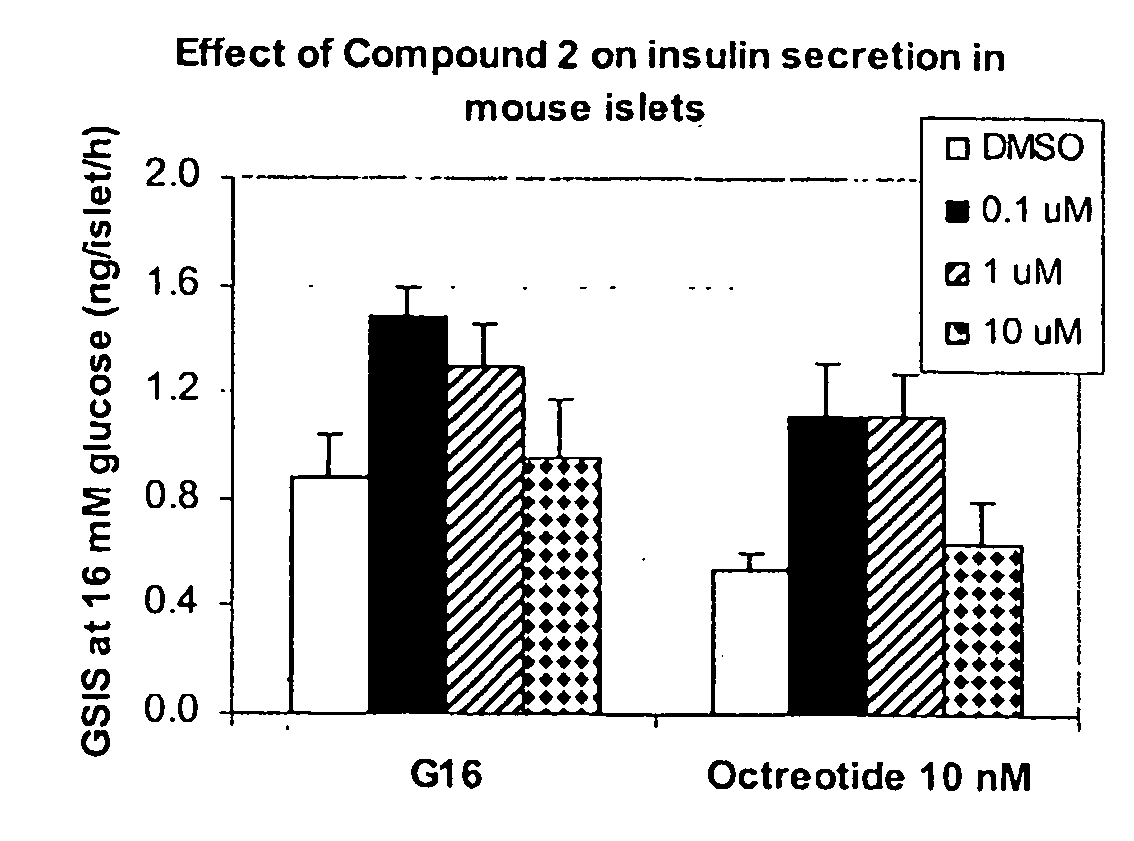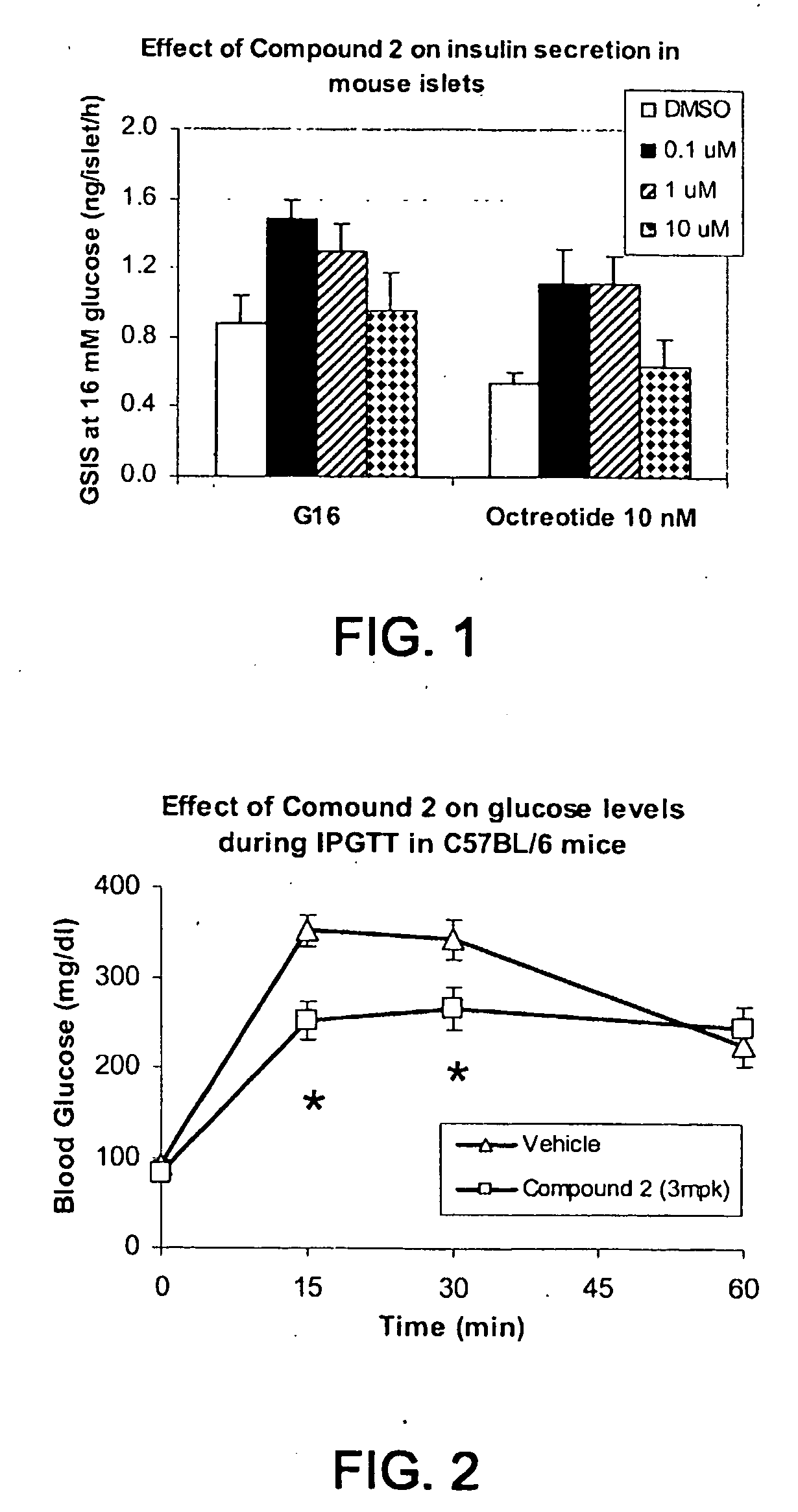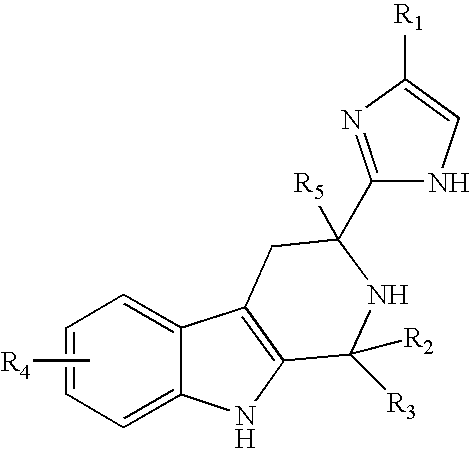Diagnosis and treatment of type 2 diabetes and other disorders
a type 2 diabetes and other disorder technology, applied in the direction of metabolism disorder, instruments, drug compositions, etc., can solve the problems of reducing the insulin effectiveness of stimulating skeletal muscle glucose uptake, reducing the insulin secretory response to glucose, and diabetic patients, etc., to reduce blood glucose level, inhibit receptor activity, and increase insulin secretion
- Summary
- Abstract
- Description
- Claims
- Application Information
AI Technical Summary
Benefits of technology
Problems solved by technology
Method used
Image
Examples
example 1
Up-Reputation of SST3 by High Glucose in INS-1 (832 / 13) Cells
[0077]Regulation of the gene encoding SST3 was evaluated by measuring gene expression in INS-1 (832 / 13) cells. INS-1 (832 / 13) is a glucose responsive insulinoma β-cell line. (Hohmeier et al., Diabetes 49:424-430, 2000.)
[0078]INS-1 (832 / 13) were cultured in RPMI medium with low (2 mM) and high (16 mM) glucose for 24 hours before being collected for RNA extraction. Insulin secretion from the 832 / 13 INS-1 cell was very low at 2 mM glucose, but is several-fold higher at 16 mM glucose. Each treatment was performed in triplicate (i.e., three experiments on three separate days).
[0079]The collected RNA samples were hybridized to oligonucleotide microarrays to identify glucose signature genes. Agilent 60-mer oligo microarray technology, which is a two-channel platform, was used. With this technology, two RNA samples are separately labeled with different fluorescent dyes (Cy5 and Cy3) and are then competitively hybridized on a singl...
example 2
SST3 Gene Expression is Highly Enriched in Mouse and Rat Islets
[0082]The relative expression level of SST3 gene expression in pancreatic islets versus various other tissues was assessed by DNA microarray using a Body-Atlas. The Body-Atlas is a molecular anatomic atlas detailing the expression level of different genes in each tissue or cell-type.
[0083]Total RNA samples were extracted from a comprehensive collection of tissues (including the pancreatic islets) for normal C57BL / 6 mice and Sprague-Dawley rats and hybridized to microarrays (Mouse TOE 75k v1.0 and Rat 50k v2.1) to generate the mouse and rat islet body atlas data, respectively. In each version of the body-atlas, a reference pool of RNA sample was composed by pooling an equal amount of RNA from 10 different tissues. Samples from each tissue (such as islets) were hybridized against the reference pool to obtain the relative expression of each gene.
[0084]On the mouse microarray used to construct the mouse body atlas, the probe...
example 3
Detection of SST3 Gene Expression in Human Islets by Fluorescence-Based Real-Time PCR
[0086]The expression levels of all five somatostatin receptor subtype in human islets from two different donors and 7 non-islet tissues were determined by the Taqman real-time PCR method. Fluorogenic Taqman probes specific for human sst1, sst2, sst3, sst4 and sst5 were purchased from Applied Biosystems (Foster City, Calif., the catalog numbers are Hs0265617_s1, Hs00265624_s1, Hs00265633_s1, Hs00265639_s1 and Hs00265647_s1 respectively). Absolute mRNA levels for the genes of interest were determined by real-time reverse transcription reaction using the ABI PRISM 7900 Sequence Detection System from Applied Biosystems (Foster City, Calif.) through 40 cycles. β-Actin probe was used as reference to determine the relative abundance of the each gene in different tissues.
[0087]The Taqman results showed that sst3, along with sst5, are the two most abundant SST expressed genes in two separate human islet samp...
PUM
| Property | Measurement | Unit |
|---|---|---|
| pH | aaaaa | aaaaa |
| β-cell mass | aaaaa | aaaaa |
| resistance | aaaaa | aaaaa |
Abstract
Description
Claims
Application Information
 Login to View More
Login to View More - R&D
- Intellectual Property
- Life Sciences
- Materials
- Tech Scout
- Unparalleled Data Quality
- Higher Quality Content
- 60% Fewer Hallucinations
Browse by: Latest US Patents, China's latest patents, Technical Efficacy Thesaurus, Application Domain, Technology Topic, Popular Technical Reports.
© 2025 PatSnap. All rights reserved.Legal|Privacy policy|Modern Slavery Act Transparency Statement|Sitemap|About US| Contact US: help@patsnap.com



